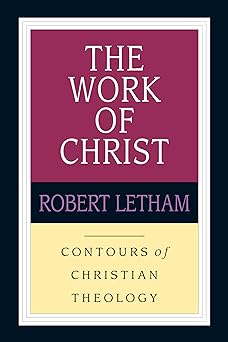A Brief Book Summary from Books At a Glance
by Mark Baker
About the Author
Robert Letham serves as Professor of Systematic and Historical Theology at the Union School of Theology. He is the author of many books including The Holy Trinity and Union with Christ.
About the Series
The Contours of Christian Theology series aims to give a systematic treatment to major doctrines of the Christian faith. “Top priority has been given to contemporary issues, some of which may not be dealt with elsewhere from an evangelical point of view” (9). It also seeks to “rework the orthodox evangelical position in a fresh and compelling way” (9).
Overview
This book provides a historical and systematic overview of the work of Christ. It uses the three-fold office of prophet, priest, and king as an organizing principle. While there are many facets of salvation (e.g. justification, sanctification, adoption, etc.) the primary way in which the believer receives salvation is through union with Jesus himself. Indeed, union with Christ is the hub for all parts of salvation. Because of this focus, we will not miss Jesus because of an overemphasis on his salvific benefits. Additionally, union with Christ provides a connection between soteriology and other key doctrines such as ecclesiology. We are saved by Jesus and also saved into his church. Soteriology, as with all of systematic theology, should not be siloed off into a hermetically sealed study; rather, this key part of theology also helps inform other wonderful doctrines.
Table of Contents
PART ONE: FOUNDATIONS
1 Christ’s Work in Context
2 Christ and the Plan of Salvation
3 Christ and the Kingdom of God
4 Union with Christ
PART TWO: CHRIST AS PROPHET
5 Christ and the Word of God
PART THREE: CHRIST AS PRIEST
6 Christ’s Human Priesthood
7 The Nature of the Atonement
8 Theories of the Atonement
9 Atonement and Justification
PART FOUR: CHRIST AS KING
10 The Mediatorial Kingship of Christ: The Cosmic Dimension
11 The Mediatorial Kingship of Christ: The Corporate Dimension
Appendix: The Intent of the Atonement
Summary
PART ONE: FOUNDATIONS
Chapter 1: Christ’s Work in Context
The phrase “the work of Christ” might sound bland to your ears. But think about it: in the twentieth century, several totalitarian atheist regimes could do nothing to stop the advance of Jesus Christ. Those regimes are now gone, but the church of Jesus Christ remains. In this book, I will use the threefold office of Christ as prophet, priest, and king to describe the work of Christ. As prophet, Jesus speaks the word of God; as priest, Jesus offers himself as a vicarious sacrifice; as king, Jesus reigns over the church and the world as the risen Lord (22). There are two dangers of this approach that I attempt to avoid. First, though I will treat these three offices separately, we must remember that Jesus performs the works of these three offices simultaneously. Second, we must also remember the fundamental unity between the person and the work of Christ. Though this book covers the work of Christ, all his work stands firmly on the foundation of the person of Christ.
Chapter 2: Christ and the Plan of Salvation
“How the work of Christ fits into the theme of God’s covenant is a crucial question” (39). The biblical covenants can be seen as the framework that supports God’s great plan of salvation. A covenant is not like a contract that provides an exchange of goods between equals. A covenant is a gracious act of God’s sovereignty to establish and maintain a relationship. Though there are many covenants given in the Bible, the central promise remains the same: “I will be your God, you shall be my people” (42). Additionally, all the covenants ultimately “disclose God’s one great promise and gift, Jesus Christ his Son” (47). Just as Christ is central in the covenants, so Christ also plays a key role in election. Christ as the foundation for God’s election of believers was once common in Reformed circles; the connection is celebrated by John Calvin, and John Knox, among others. But soon Christ’s election became a key tenet of Arminian theology, and therefore this connection was deemed suspect by subsequent Reformed theologians. The Bible, however, has never had a problem with this doctrine, and we should see it as a source of joyous confidence and comfort (56). . . .
[To continue reading this summary, please see below....]The remainder of this article is premium content. Become a member to continue reading.
Already have an account? Sign In
Buy the books

THE WORK OF CHRIST, by Robert Letham